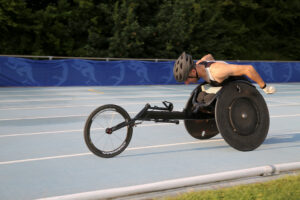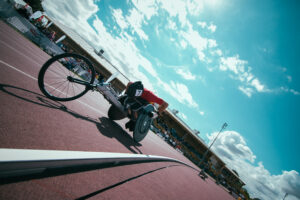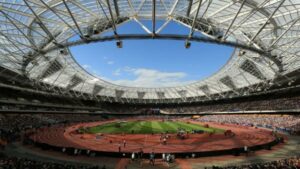Your basket is currently empty!
Does Paralympic sport benefit the right athletes?

Paralympic sport has come a long way from its humble beginnings at the Stoke Mandeville spinal cord injury unit in England just after the Second World War. This small sporting event, which at the time used competition between those with similar injuries to assist the rehabilitation of wheelchair users, is now a worldwide phenomenon. The movement now boasts a 4 yearly event working in conjunction, and very much on a par, with the Olympic Games. In addition many of the individual sports have their own international sporting events governed by the IPC (International Paralympic Committee) and run separate international event calendars. Competitors in these events are often household names and on many occasions able bodied and para sports run events alongside each other as is currently happening with the IPC para athletics championship in London. The transformation of disability sports has been amazing as has its influence on the quality of the lives of disabled people in general over the same time frame. However in more recent years is the direction of movement for those involved in para sport the correct one? Is it time we had a serious and perhaps difficult conversation about who benefits and who doesn’t from how things have changed with Paralympic sport? Are we still helping those who the movement was set up to help? And while the success of the movement in general is a really good thing, do the inevitable commercial pressures of this success actually have some negative impacts on inclusion and participation of those with disabilities? There are a number of areas in relation to this that could be discussed, however I would like primarily to give my thoughts on what I see as the direction of travel of the Paralympic movement. Are we seeing those with more severe disabilities losing out to those with less severe disabilities? Is there enough representation for those who are much further from having fully working bodies than those who have smaller impairments and if so, why is this? I will move onto my thoughts around this subject later in the article but to begin with I think it might also be worth discussing another area – classification, to understand more about what is happening. Importantly I don’t want this article to be a criticism of the Paralympics and para sport itself, governing bodies within it or individuals (athletes or otherwise). What I do want to do is begin a discussion about where we think it should be going in the future. This discussion might be difficult to hear but I think it is one that ultimately needs to take place, and take place now.
Before I let you know about my thoughts on all this, a bit of background on me would probably help. I have a C5/6 incomplete spinal cord injury and I live in the UK. Over many years I have competed to a decent level in wheelchair rugby and wheelchair racing and I have also been involved in other disability sports. I can only speak from my personal experience and from knowledge gained from others I have met in that time. Although I have been selected to represent team GB in the past I want to make it clear I am not writing this out of frustration for not being selected for my national squad for any particular event – I wasn’t where I needed to be in the world rankings for my classification to achieve selection and I understand that.

Classification adjustments and the knock on effect.
Classification is always going to be a difficult area and will always have controversy around it. There has been some controversy regarding Paralympic classification in recent times. It is a situation pretty much exclusive to the disability sport movement and is there for a very good reason. It was designed to allow people of a similar physical ability to compete against others with roughly the same physical ability. It is not a perfect system and there will always be those who benefit from being at the top end of a particular classification bracket and also those who may find it harder as they find themselves in the lower end of that bracket. I have been participating in disability sport for well over a decade now. I am by no means an expert in classification so all I aim to do here is bring up some topics for discussion around disability classification. I will begin with some of my own thoughts and experiences of classification in the sports I have played over the years.
My view is that in both wheelchair rugby and track racing over the last few Paralympic games, those with more severe impairment have been squeezed out the bottom of the sports they love by different disability types and borderline classification calls gradually raising the bar of who they can actually compete with. My category in racing – T52 is a mixed disability classification in which athletes who exhibit similar muscle strength and movement compete together. In recent years the classification boundary has moved a little which has allowed athletes with different disability types but who still exhibit similar muscle strength to enter our category when they would previously have been in the category above us. Many of these new athletes are great athletes, nice people and good friends of mine. It is not their fault that they have been categorised the way they have and on the surface they exhibit very similar muscle activity to others in this classification. However when you look more closely there are other differences that are important in addition to muscle strength which means things are not necessarily a level playing field. For example those with a higher level spinal cord injury (a neck injury rather than a back injury) cannot elevate their blood pressure and heart rate to the same extent as a non spinal cord injured athlete with the same muscle strength. There is a direct relationship between athletic performance and elevation of blood pressure and heart rate. An athlete with the same body function and fitness but who’s heart rate and blood pressure is restricted due to their disability type will not achieve the same output as one who is not restricted in this way. I understand that athletes of all disability types also need the opportunity to race in a category that is appropriate for their disability. My concern is the knock on effect of adding more and more athletes to the top end of classification boundaries and how this affects those sports and who can compete in them in the long term.

I believe this has also happened in wheelchair rugby. When I began playing wheelchair rugby it was a sport nearly exclusively played by those with spinal injuries. In fact it was invented by quadriplegic wheelchair users in Canada as they found it difficult to take part in wheelchair basketball due to their lack of hand function and strength. Classification for wheelchair rugby players ranges between 3.5 and 0.5 points and a team is made up of 4 players totalling no more than 8 points. When I was first classified as a wheelchair rugby player I began as a 3.0 point review player which after a few years dropped to a 2.5 point player. If I was classified now I would most likely come out as a 2.0 pointer. The extent of my disability has not changed much in this time but the classification boundaries have slightly shifted. Many players who would previously have been considered “too able” to play are now playing as higher point players which has a knock on effect throughout the whole classification system. In many seemingly positive ways this makes the game look faster, more dynamic and exciting and adds to the diversity of which disability types can play the game but this also has negative consequences. These classification adjustments have meant that the previous high point players are now mid-point players, those mid-point players are now lower point players. The problem with this is that those who were previously the lower point players, the 1.0 and 0.5 pointers, the ones who struggle the most to find competitive sports to play, now struggle to compete at all. Where do they go, what sport do they play? This was a sport set up specifically for those who, through no fault of their own or lack of training, were unable to compete at basketball. Where do these dedicated athletes go in terms of sport when they are getting pushed out the bottom end of the sport that was designed for them? I wanted to highlight some of the issues I have noticed in classification as it has implications for Paralympic sport in general. It’s not an obvious and rapid change and some may say that as disabled athletes train harder and techniques and equipment improve this movement of classification boundaries will naturally shift slightly. However I disagree. I think it is more than this and I do believe it is a cause, or perhaps a symptom, of a trend in disability sport moving in this direction. In my mind the Paralympic movement was set up to give sport to those who could not play it with able bodied competitors. Those who had no chance to even play, yet alone compete with, able bodied athletes then had sports and organisations enabling them to do one of the major things they desired to do – compete, with others like them.
A shift in athlete recruitment.
I have noticed a shift recently towards sports finding people with minor impairments who are already playing alongside able bodied competitors and didn’t previously consider themselves “disabled” and recruiting them into para sport. Much as I fully welcome inclusion it seems like much more of this has been happening recently and I don’t think it is the direction we should be going in. Many sports seem more intent on finding people with very minor disabilities who are currently quite happy being involved in the sports they were already managing to take part in and making them great Paralympians. These people are already involved in sport and are active and healthy because of it. Whereas what I think should be happening is that the people who are currently struggling to take part in sport due to their disability are encouraged to participate and have opportunity to compete to a high level if they decide to and show the ability to do so. Much as there is value in elevating those with minor impairment to compete with others in similar positions, it really only serves to win medals and therefore funding for national squads. I don’t want to single out particular sports but as an example the recent British para rowing recruiting video did actually say words to the effect of “you may only have a slight impairment or not consider yourself disabled but you may still qualify for para rowing”. I completely see why this needs to be said as GB rowing wants to win lots of medals, as do other sports. However I am concerned as there are a limited number of sports and events at any Paralympic games. There are some sports and events that are for athletes with very minimal disabilities or impairments that many would argue are taking away possible events for those with more severe disabilities who are just simply not able to compete at all if their events are not included. Some impairments allow athletes to compete very easily with their able bodied counterparts and tough as the question may be, we need to ask if these sports should actually be included in a paralympic games? I am not an expert, and I understand this directly affects some athletes currently competing, which sounds like I am being unfair to them. However, in my mind if you have, for example, a minor upper limb amputation or your eye sight is affected but you can still see the lines on the track, you can still compete with able bodied runners (particularly over long distance), throw a javelin, or do the long jump. These athletes who are much less affected by their disabilities do often produce events that can look visually more exciting. The athletes look more like the stereotypical view of an able bodied Olympian. They are often much easier to sell to the media. Their bodies and the way they move are more similar to what an untrained able bodied viewer would be used to seeing in athletic competition. But those with a greater degree of impairment train just as hard, struggle to overcome the odds just as much and deserve as much, if not more, opportunity to demonstrate to the world their physical prowess in competition as anyone else. As new sports and new events fight their way into para sport and the Paralympic games, are we allowing too many sports and events for those with minor impairment? At every games there are limits to the amount of medals on offer and when a sport or event is added it doesn’t mean there are more events, it just means that some others get pushed out. Inclusion is great but when inclusion for those with minor impairment means fewer events for those with more significant impairment that actually becomes exclusion! That exclusion is also at the expense of those who should benefit from inclusion the most.

There is an understandable temptation for national sporting bodies to pick less disabled medal hopes over equally likely medal hope but more disabled athletes. It is unfortunate but true that it is easier and more cost effective to transport and accommodate the needs of someone with a minor disability than someone with a more severe disability. I believe that there are times when the full support they need is not given to athletes with higher disabilities levels because of cost implications. I believe this may be happening in developed countries national bodies when money is less of an issue, so is much more likely to be happening in places where finance for para sport is a larger issue. If you base funding on medals and you have limited resources to get those medals economics dictates you will spend those resources on the cheaper way to get medals. If there is equal opportunity for medals between 2 athletes, the “less disabled” athlete is the easier and cheaper one to select for the same medal opportunity. This sadly can be a more tempting prospect for National selectors. But when this happens it is at the expense of individual athletes with severe disabilities within all sports and also to the sports originally designed with them in mind. I am concerned about the lack of possibility for selection for those who have had the classification boundaries moved above them to let more able athletes in and other sports where lack of disability is what coaches are looking for rather than talent, ability and determination.
Do we need a change in emphasis?
It all seems to point towards national bodies scouting for the least disabled in a classification (which will always happen) but also the least effort in converting someone already competing in a sport, not realising their minor disability allowed them to be eligible, over helping someone who has a more severe disability but could be a great athlete to learn a new sport from scratch. It now often seems a bit like the “nearly able” are taking over Paralympic sport while the less able struggle to have events to compete in. I don’t believe it is a deliberate change of direction by the Paralympics but more of a slow slide in that direction. The Paralympics has been an awesome movement for positive change in the lives of disabled people, but I think we need to be aware of this slide and evaluate if it is helping to do what the Paralympics was initially set up to do. Is it helping to motivate and inspire to get active, those it was set up to help? If it is not being as effective at this as it should be, do we need to make some changes, as difficult as that may be, to readdress that balance? The success of the Paralympic movement itself should not be underestimated but has this success ultimately distracted us from its original aims?
Rob Smith
Wheelchair racer and disability sport athlete,
Director of the Active Hands Company.
July 18th, 2017
